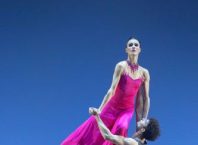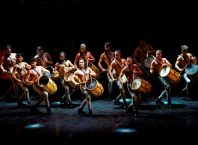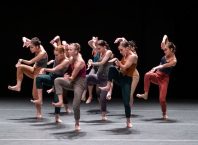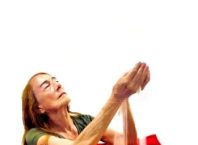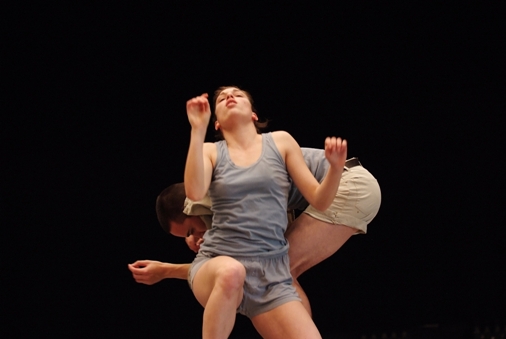
The day before the Batsheva Ensemble brings Kyr/Zina back to the stage at Suzanne Dellal as part of International Exposure 2010, Nitsan Margaliot, a member of the Ensemble, shared his thoughts with Midnight East.
Kyr was created by Ohad Naharin in 1990 – the first dance work he made for Batsheva after taking on the artistic direction of the company. Born in Modi’in, Israel, in 1991, Nitsan is a year younger than Kyr, underscoring the sense of history imbued in this dance that is a significant landmark in Israeli contemporary dance. The dance includes several different sections, one of them – Ehad Mi Yodea – performed in a semi-circle to the rock group Nikmat HaTraktor’s (Tractor’s Revenge) version of the familiar Passover song, has become one of Naharin’s most performed and best popularly known choreographic work. Ehad Mi Yodea has been part of the choreographic collage Naharin created for Anaphase, Zachacha and Deccadance, yet Kyr in its entirety was not performed for many years, until its revival in 2010, celebrating Naharin’s 20 years with the Batsheva Dance Company.
“It was interesting to be part of the process,” says Nitsan, who joined the Batsheva Ensemble in 2009, and participated in the experience of setting the work on the Ensemble as Naharin combined Kyr with Zina, created in 1995, into one dance program. “Although the Ehad Mi Yodea section has been performed many times,” said Nitsan, “Kyr is the original; it’s exciting to see it from within, where it began. You can see something different in it each time, it’s a never-ending process.” The Ensemble attracts young dancers from all over the world, this year, 12 new dancers joined the Ensemble. Dancers typically remain in the Ensemble between 1 – 2 years, so that the cast is continually changing, something that Nitsan says is “very refreshing and brings new energy to the work.” Nitsan compares this to the performances of works such as Kamuyot that has three different casts, with each cast he says, “the movements are the same but the interpretation is different.”
Nitsan’s own beginnings in dance were casual. As a 4th grader in Modi’in looking for an after-school activity, he began dancing in a local folk dance group. He was also involved in music at the time, playing the drums, but dance gradually became more important and he eventually decided to study dance more seriously. Attending the Jerusalem Academy of Music and Dance high school meant commuting daily from Modi’in, but at that point he says, “I knew that I wanted to invest more in dance and develop as a dancer. Dance became more meaningful to me in high school, in the last year I was dancing from 7:30 in the morning until 10 at night.”
Studying dance at the Academy included classes in classical ballet, modern dance methods such as Graham and Cunningham, and learning a repertory of choreography. It was there that Nitsan first encountered gaga, the movement language that Naharin developed to work with his dancers. “I learned the choreography of Israeli choreographers – Naharin, Yasmin Godder, Idan Cohen,” recalls Nitsan, “I learned the choreography of Mats Ek with Talia Paz. High school was a time of intensive study in which I worked with many people I admire, like Melanie Berson, and I also had the freedom to create.”
In the Batsheva Dance Company the dancers train through gaga, of which Nitsan says, “Gaga gives you what you get from all the other systems – ballet, Graham, Cunningham. It gives you a lot of freedom without cancelling anything, it only adds to what you have learned elsewhere. It is a never-ending process of learning.” Members of the Ensemble have many opportunities to perform, both in Israel and abroad. Nitsan has already been on one tour to Miami with Deccadance, and performed countless times in Israel, including performances of Kamuyot for schoolchildren. “We often appear in places where people don’t have many opportunities to see dance,” said Nitsan, “performing Kamuyot in the schools is fun, and the children really connect to it. They change through the performance, they undergo a process with the dancers – it’s a once in a lifetime experience.”
Inspiring others through dance, Nitsan draws his own inspiration from family and friends. When he has time off he likes to spend it with them. In terms of cultural activities he says, “I like to see dance, to see the things that are happening here.”
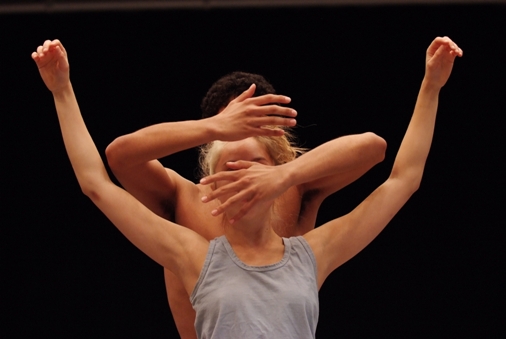
The evening’s program begins with Kyr, a work that is composed of several different sections. Within the dance company, each section is given an identifying name, usually related to a characteristic of the particular section. For example, the first section of Kyr is known as “March” because of the tempo of the accompanying music. When asked about the feeling of performing Kyr/Zina with its fast pace and very articulated complex gestural language, Nitsan says, “It is an intensive experience, not demanding, but … March is not a “light weight” experience from my perspective. I think it is a combination of precision and freedom. From the outside it appears to be very restricted but I feel a great deal of freedom, letting go…to take it to your own place, to your body. I can find it in my body.”
The transition within the work from Kyr to Zina is with Kamos, “and the atmosphere of Kamos” as Nitsan refers to it. Originally created for the NDT (Netherlands Dance Theatre) in1995, taking its name from the polar night in Finland that can last over 24 hours; Kamos generates a very different mood. Performed to a soundtrack composed by Ivri Lider, the dancers wear earphones through which they hear a soundtrack different from the one played for the audience, creating an interesting dissonance. Zina moves on from the initial scene of Kamos to other moods and moments, but when asked for his take on the evening as a whole, Nitsan says, “I don’t like to interpret the dance; I prefer to let each person take it to his or her own place.”
Kyr/Zina is a very dynamic evening with many transitions and, as Nitsan says, “lots of emotions,” in which every viewer can connect to a different journey. The absence of a single narrative creates the freedom to imagine several narratives or none, making each performance a different experience. “What is beautiful about art,” says Nitsan, “is that it changes before your eyes. You change, your “head” changes, your life changes, and you can see a painting differently… but dance on the stage – moves!”
Kyr/Zina by Ohad Naharin
Performed by the Batsheva Ensemble: Bret Easterling, Olivia Ancona, Gon Biran, Danielle Ben-Hamo, Omri Drumlevich, Danielle Gal, Nitsan Margaliot, Eduard Turull, Marija Slavec, Stav Struz, Lotem Regev, Nitzan Ressler, Gil Shachar, Maayan Sheinfeld, Or Schraiber, Maya Tamir.
Performances will take place at the Suzanne Dellal Centre, 8 Yehieli Street, Neve Tzedek, Tel Aviv. Tickets: 03-5104037 and the Batsheva Dance Company site.
New Performance Dates: December 27, 28 & 29 at 21:00.

